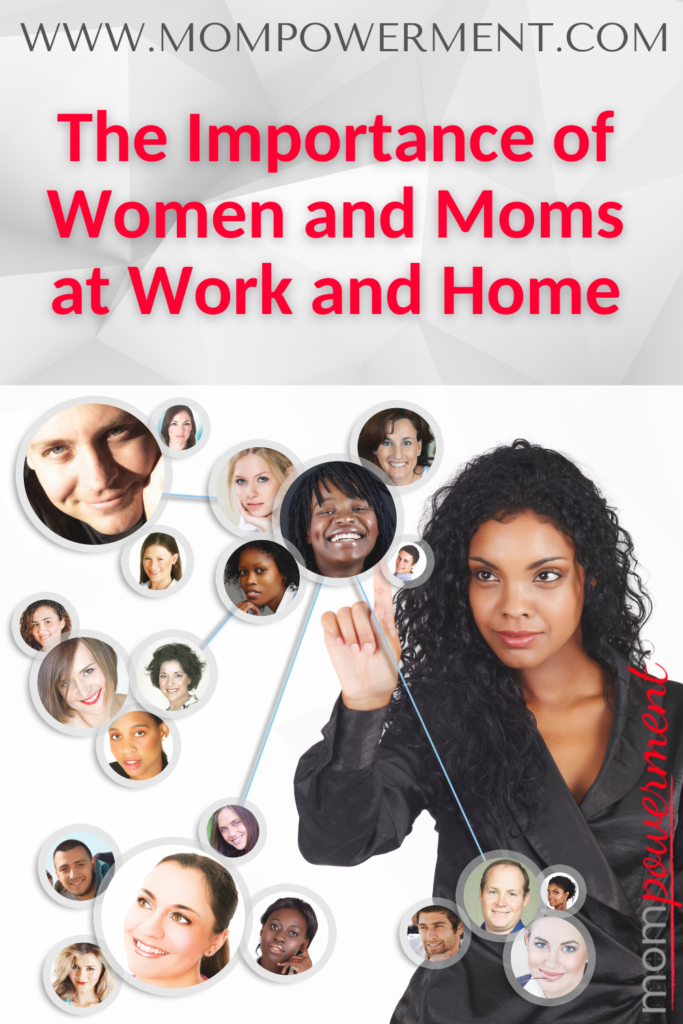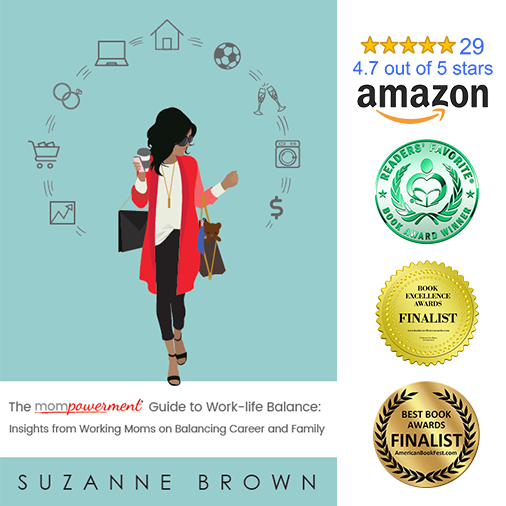
While I’m thrilled it’s International Women’s Day, we need to celebrate, support, mentor, hire, and promote women every day. Simply put, it’s the right thing to do. Often that isn’t enough. Consider that taking action on behalf of women in your organization and community has a positive impact on many levels. When women in the workforce and women business owners thrive, everyone benefits. Let’s consider the importance of women and moms at work and home.
1. Women business leaders positively impact stakeholders. Think that having women at the top only benefits women? Nope! An analysis of 22,000 companies1 found that those that go from having no women in corporate leadership (e.g., the board and C-suite positions) to women in 30% of these roles see a one-percentage-point increase in net margin. That translates to a 15% increase in profitability for a typical firm.1 That financial lift can positively impact all stakeholders: employees, leaders, investors, suppliers, etc.
2. What about women-owned businesses? When we’re talking about the importance of women and moms at work and home, we need to look at small businesses. Consider that small business is generally 99+ percent of businesses in the U.S. and they give jobs to almost 47 percent of employees.2
According to the SBA, women own about 43 percent2 of small businesses in the U.S., which is more than 14 million businesses. In the 2019 report commissioned by American Express, we learn that these businesses generate about $1.9 trillion per year.3 Yes, it’s almost $2 trillion. Talk about making an impact on their communities and the economy! In many cases, these businesses fill a gap in the community (e.g., at-home childcare or elderly care). And that approach has financial and societal benefits.
3. Women and soft skills. Companies are (finally) recognizing that soft skills that move the needle for their employees. It’s not only about knowledge. You need emotional intelligence, empathy, communication skills, and the ability to connect with those around you. A Korn Ferry4 study shows that women are more likely to possess these skills.
The pandemic put a spotlight on these other skills that contribute to success. And when they’re missing, we see the negative effect of things like burnout and feeling like you’re not getting support or that you don’t belong. During the pandemic, burnout and a misalignment between life and work led employees to seek other employers. And we saw the impact of the Great Realignment. (It was more than a Great Resignation.)
4. More diverse teams can help with innovation.5 If you have many of the same people on your teams, it becomes an echo chamber. Diverse thought needs different types of voices, which often comes from having both genders and people of different backgrounds at the same table. And this variety can better represent your customers and their perspective. It can be hard to innovate and problem-solve if you don’t understand the mindset or needs of your customers. And an added benefit is that diverse teams can be more productive.6
OK, you’re hopefully better understanding the importance of women and moms at work and at home. Since I help empower working moms to be at their best, let’s talk about the impact of working moms.
5. Society benefits from having working mothers in the workforce. While many in the U.S. feel that mothers should stay home, we can see the positive effect on their children. A worldwide study7 of more than 13,000 women and 18,000 men, found that daughters of working moms are more likely to have jobs, earn a higher wage, and have supervisory roles versus daughters of SAHMs. Men whose mothers worked are more likely to spend more time on family care duties than those whose mothers stayed home.
6. One-third of women at work are mothers. Working mothers are about a third of the workforce (according to McKinsey’s 2021 Women in Workplace Report) and about a third of women business owners (that’s more than 4 million businesses!).
In the workplace, you’ll often find working moms (and dads) in middle management positions. This layer is integral to the success of companies today and long term. This layer can either become the leaders of tomorrow or support the leaders of tomorrow. Either way, it’s clearly an important part of businesses.
The one in three women who own businesses who are mothers also matters. Mom-owned businesses are part of an economic engine that has lasting effects on communities.
7. The economic impact of working mothers. I mentioned earlier that it’s the right thing to do to support women and working mothers. Women are half of the population. We should want them to succeed. And with working mothers as a third of women (essentially 1/6 of the U.S. population), we need to support their needs as well.
Consider the economic impact of better supporting working mothers. Consider that 1.4 million of whom were working mothers,8 left the workforce during the pandemic. Think about how we’re all affected by that loss. There is an economic ripple effect of the lack of that income. The St. Louis Fed9 wrote that supporting working mothers and “closing gender gaps in earnings, employment and hours worked…could add $1.7 trillion to the nation’s GDP each year.” That same report also talks about how increasing women in the workforce helps the U.S. become more competitive on the global stage.
Take action to support working mothers
You might be thinking, “I get the importance of women and moms at work and at home, but what can I do?” There are a variety of ways that you can support women and working mothers as a member of a household, a community, and a business leader.
What can you do in your household?
Are you creating a partnership at home? Whether or not you have children, consider how you’re currently dividing household duties if you have a significant other. If not, how can you better divide household duties?
If your significant other is a working mom (i.e., you have children), how can you be a better partner with household and childcare duties? Things like comparing calendars each weekend so that both of you have the chance to be the default parent during the week. Look at how you divide up household chores. If you’re looking to have a more strategic and meaningful conversation, you can download the Mompowerment Guide. Understand that creating that support at home benefits the working mom in your life, you, and your children.
While we don’t often think about it, another way to support your significant other is through voting. Vote for politicians that understand the impact of legislation on the lives of women and working mothers. We need our government to do a better job of creating a sustainable infrastructure for working mothers and that starts with things like federal paid leave for parents.
What can you do as a member of the community?
As a member of the community, you can make simple shifts that have a big impact. Include buying products and services from mom and women-owned businesses from the list of companies you do business with. Not their ideal client? Recommend their products and services to people you know who are their ideal clients. You can like, save, and share their posts on social media. Mentor them so they can grow their businesses. Connect them with decision-makers who provide funding.
As an ally at the office, help managers, decision-makers, and company leaders understand the skillsets of your female colleagues. Help them be heard in meetings and other places where there are lots of voices, including male voices that might drown them out. Recommend your female colleagues for projects where you know they will shine or learn valuable skills. Call out gender bias and find solutions to offset that bias. Mentor them to help them make better professional and business decisions. Help open doors for them, especially as they return to work.
Consider hiring a woman-owned business when you look at outside vendors for services. Buy their products.
How can you help women and working moms as a company leader?
As a company leader, you can make a big impact on the lives of women and working mothers in your organization. Develop a company and infrastructure to help women and working mothers thrive. Pay women and working mothers what they’re worth. Yes, pay equality matters at a fundamental level! Promote the women in your organization and stop thinking children will keep them from being phenomenal in their next role. Give mid-level and junior team members access to you and other senior leaders to develop relationships over time (sponsors help open doors!!). Ensure you have women in some of your leadership positions, including on your board.
Develop mentorship programs and create and support Employee Resource Groups (ERGs) for women and/or working mothers. Pay for parental, not only maternity leave, and actually support the working moms and dads who take time off as they welcome a child into their lives.
Support legislation that could create a city, state, or federal paid leave for parents. Politicians listen to company leaders, so you definitely have decision-makers listening to you.
Hire women and mom-owned businesses when you’re looking for vendors for new opportunities. If you’re able to fund new businesses, invest in companies created and built by women and working mothers.
I’ve given you 7 ways that highlight the importance of women and moms at work and home.
How are you supporting women in your household, community, and/or organization?
If you’re interested in learning more about the importance of working mothers in the workforce, read the Mompowerment post specifically about this. Want to know more about women and working moms as business owners? I’ve got a Mompowerment post for this.
1 https://hbr.org/2016/02/study-firms-with-more-women-in-the-c-suite-are-more-profitable
3 2019 State of Women-Owned Business Report commissioned by American Express
8 https://www.census.gov/library/stories/2021/03/moms-work-and-the-pandemic.html
9 https://www.stlouisfed.org/open-vault/2022/jul/benefits-of-supporting-working-moms


